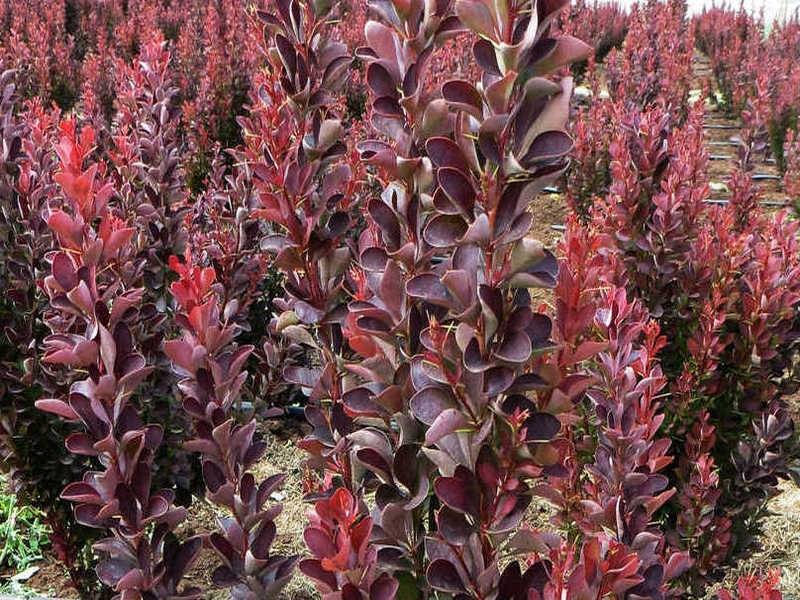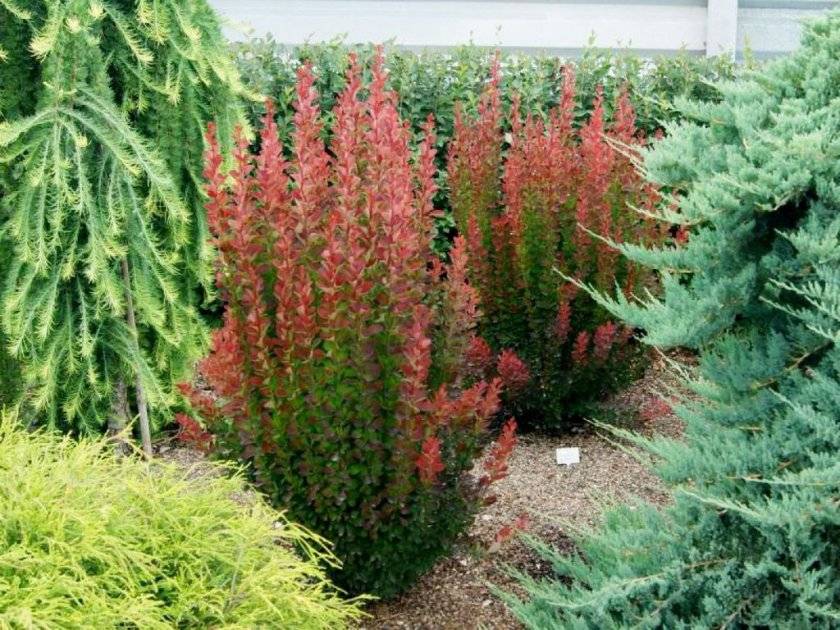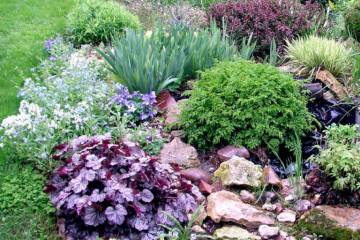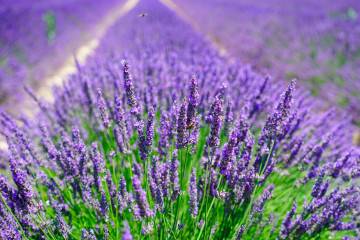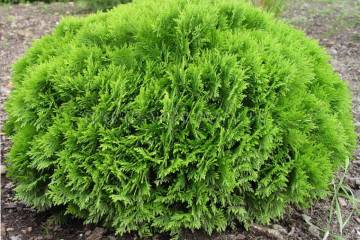Barberry Red Pillar - description and cultivation
Content:
Under natural conditions, the Thunbergii barberry grows in Europe, North America and the Far East. Many new varieties have been bred on the basis of wild varieties of shrubs. They have excellent external and biological properties. Among them is the barberry Red Pillar.
Description of barberry Red Pillar
The shrub has a columnar crown. Its height ranges from 1.5-2.5 m. The branches are arranged vertically, which gives the crown a compact appearance.
The underside of the foliage is reddish, while the outside is purplish purple. This gives the plant a decorative effect and allows it to be used to decorate the site.
The root system is in the form of a short taproot with a large number of small root processes.
At the end of flowering, oval coral fruits are formed in place of flowers, the length of which can be from 1 to 1.5 cm. The fruits stay on the branches for a long time.
Planting a plant
Thunberg Red Pillar barberry can be planted in several ways. Among the most common are the following.
From seed
Seed planting of a plant is the most difficult and time consuming process. To collect planting material, you need to collect the berries by separating the seeds from the pulp.
In early autumn, seeds are sown in open ground to a depth of 1-1.5 cm. In spring, young shoots appear. After 2 leaves appear on them, the seedlings are thinned out, the distance between them should be at least 3 cm. The seedlings are grown on this bed for 2 years. After that, they can be transplanted to a permanent place.
Sowing seeds in the ground in spring is possible. To do this, they must first be stratified (seeds are mixed with sand). In this form, the seed is stored in the refrigerator for 2-4 months. With the onset of spring, seeds are sown in open ground.
Planting seedlings in open ground
Seedlings can be planted in spring or fall. Experienced gardeners recommend doing this in the autumn, since the seedlings will take root better in a new place.
When choosing a seedling, you need to pay attention to its bark system, the roots should not be dry and damaged.
Each seedling is placed in a previously prepared hole 40-50 cm deep. A peg must be inserted into the hole, which will support the young seedling.
When planting, the roots of the plant should be carefully straightened. The root collar of the barberry should be located at a depth of 4-5 cm. Having covered the seedling with earth, it is thoroughly watered with water. It is recommended to mulch the trunk circle with dry foliage or sawdust.
How to care for barberry Red Pillar
In order for the shrub to be healthy and have an attractive appearance, it is necessary to provide proper care for it.
Watering
Barberry Thunberg Red Pillar does not need additional watering with normal rainfall. Watering the plant is necessary in extreme heat. For this, watering is carried out every week using settled non-cold water.
Heavy watering or frequent rains can have a detrimental effect on the condition of the root system of the shrub. In this case, the root begins to rot and the plant may die.
Top dressing
If fertilizers were applied when planting seedlings, they will be enough for normal growth for 12 months. The next feeding is carried out in early spring. For this, a urea solution is used (dissolve 20 g of the product in 10 liters of water).
After that, for 3-4 years, barberry is fed with nitrogen fertilizers every 2-3 months. After the end of flowering, the shrub can be fed with a solution of kemira-wagon (15 g per 10 l of water).
Pruning
Shrub trimming is performed in case of thickening or dry shoots. The first time pruning is carried out at 1 year: dry branches are removed, and the shoots are shortened by half. Thanks to this, the plant takes on a beautiful columnar shape. Subsequently, trimming is performed as needed.
Reproduction methods
Red Pilar barberry reproduces in several ways. Among the most accessible are the following:
- grafting. Cuttings should be cut in the middle of summer. The lower leaves are removed from them, and the upper ones are shortened by 1/2. The prepared cuttings should be dipped into the root-forming solution for 2-3 hours, and after the specified time, rinse thoroughly. After that, the twigs are inserted into a soil mixture consisting of humus, peat, sand and fertile soil. To create greenhouse conditions, the container with cuttings is covered with a transparent cap. In this state, they should stand for 2-2.5 weeks. Periodically, the cap must be removed for ventilation and watering. After root formation, cuttings can be planted in open ground, where they will grow for 2 years;
- layering. In the middle of spring, you need to choose strong, one-year-old shoots on the bush. They are carefully lowered into a groove in the ground 20-25 cm deep. The shoots are covered with earth, leaving only the tops of the branches on the surface. By the end of spring, the cuttings will take root, forming young seedlings. They can be cut off from the mother bush and transplanted for growing;
- dividing the bush. For propagation in this way, it is recommended to use plants from 3 to 5 years old. In the spring, the bush needs to be dug up and divided into several identical parts. A saw and a pruner can be used to separate. Places of cuts for disinfection are treated with crushed coal. The resulting cuttings are seated in prepared holes.
It is recommended to propagate barberry by cuttings or by dividing the bush, which are considered the most affordable.
Diseases and pests
Among the pests that threaten barberry, the most dangerous are aphids, sawfly or flower moth. When a bush is affected by parasites, its leaves change color, wither or dry out.
For pest control, Berberis can be treated with a solution of laundry soap or 1% chlorophos.
Damage to barberry bushes and diseases is not excluded. They are afraid of powdery mildew, leaf spot, rust and bacteriosis. You can fight ailments by treating the plants with a 1% solution of colloidal sulfur or Bordeaux liquid.
Flowering period
The flowering period begins in early May and does not last long (20-25 days). At this time, small bright yellow flowers appear on the plant. They can be arranged one at a time or be collected in groups in brushes (3-4 pcs.).
Preparing for winter
Despite the fact that the variety is winter-hardy, the barberry needs shelter for the winter. To do this, at the end of autumn, the near-stem circle is mulched with peat, compost or dry leaves.
Use in landscape design
Decorativeness allows you to use the shrub to decorate parks, gardens and local areas. It can be presented in the following forms:
- hedge;
- framing lawns;
- mixborder;
- flower bed or lawn decoration;
- rockery.
Thanks to the rapid growth, the desired result will be visible within a few years.
Healing properties
It makes sense to grow barberry of this variety, not only as an ornamental shrub, but also for medicinal purposes. All parts of the plant, except for berries, have the following healing properties:
- anti-inflammatory;
- choleretic;
- antipyretic;
- pain relievers;
- antispasmodic;
- bactericidal;
- antineoplastic;
- hemostatic.
For the preparation of raw materials, young leaves, shoots or plant roots are collected. They are dried in a shaded and well-ventilated area. Raw materials are stored in paper bags at a temperature not exceeding 25 ° C.
Decoctions of Red Pillar barberry can be used in the treatment of diseases such as indigestion, inflammation of the gallbladder, chronic pancreatitis, constipation and long-lasting wounds.
Barberry Red Pillar is popular not only with experienced gardeners, but also with beginners. This is due to its decorative appearance and unpretentiousness in care and reproduction. The medicinal properties of the plant are also important. This beautiful shrub will become a real garden decoration.
